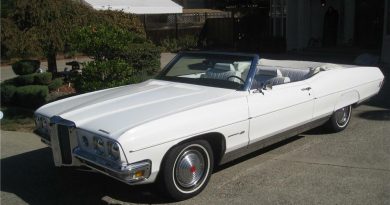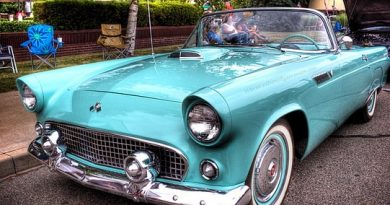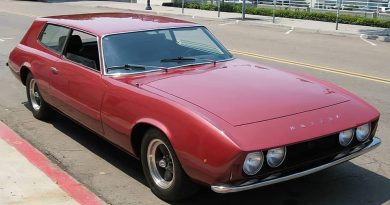1936 Horch 853 Special Roadster Recreation
August Horch began producing vehicles with Karl Benz prior to 1899, after which he began building vehicles under his own name, August Horch & Cie. In 1909, after disputes with shareholders, he departed from his company and founded Audi, which is the Latin translation of his surname. The production of the Horch automobile continued without their founder using his name.

In the early part of the 20th century, the automobiles began to appear less like horseless carriages and more like automobiles. The tiller steering and high buggy wheels became a thing of the past and the engine found its way to the front of the vehicle.
In 1926, a new model was introduced powered by a straight eight engine. This engine was used by the company for many years. Over the years it displacement size grew as did the horsepower rating. This engine was instrumental in providing the power-plant necessary to propel the luxurious Horch automobiles to quick speeds while maintaining a competitive price. As was the case with most early automotive manufacturers, Horch would either build the entire vehicle or merely supply the chassis for a coachbuilder to outfit the vehicle.
Horch was instrumental in continuing the growth of Audi as a company and on the race track. During World War I, the direction of Audi switched to producing vehicles for the military.
As was the case for most automotive companies, times were changing and becoming increasingly difficult to stay competitive and stay in business. In 1932, due to financial problems, August sold Audi. It became part of Auto Union. Auto Union was comprised of Horch, Das Kleine Wunder, Audi, and Wanderer. The Union was essential a way to continue production of automobiles while providing financial support necessary to fuel automotive racing and technology.
The Horch Series 850 featured the 100 horsepower straight eight engine, luxury, style and sophistication. The Model 853 was fitted to a shorter wheelbase and used a DeDion axle rear suspension. In an effort to stay competitive, The Model 853A became available in 1937 and featured a 120 horsepower straight eight engine.
When World War II began, production of the Horch Automobiles ceased.
Total Production was 619 cars from 1935 to 1940

August Horch was born in Winningen in 1868. After a technical education at engineering school, he worked for a marine engine manufacturer in Leipzig. This job was followed by a position managing Karl Benz’s motor works at Mannheim, which was followed by Horch seeking financial backing for his own venture. His departure from Benz’s motor works was prompted by frustrations over the conservative approach and regarding the rear-engined ‘horseless carriages’ as outdated. Horch’s first automobile of 1900 featured a front-mounted, twin-cylinder engine and shaft-driven rear axle. Larger four and six-cylinder models followed. Horch was active in competitions and trials of the day, though these excursions would bring August into conflict with his fellow directors and force his departure in 1909 to found Audi.
Paul Daimler, son of Gottlieb, was hired as Chief Engineer in 1923, to modernize the engines in the lineup. The first car to benefit from his expertise was the 300 Model. Power was from a 3.2-liter, double-overhead camshaft straight eight engine. After Daimler’s departure Fritz Fiedler designed a single-overhead cam straight-eight engine for the Horch 450, which was followed by the 6-liter V-12 powered 600 and 670 Models in 1931 and the 3.5-liter V8 engined 830B in 1933. Horch attracted wealthy clientele, and their cars wore elaborate and exclusive bodies ranging from cabriolet to a close limousine.

Horch became part of the Auto Union in 1932, joining with Audi, DKW and Wanderer. In 1936, Horch introduced the 4.9-liter Type 853 with power by a Fiedler-design, SOHC, ten-bearing straight eight mounted in a well-built chassis and fitted with a four-speed overdrive gearbox with servo-assisted hydraulic brakes providing the stopping power. The 853 and 853a would remain in production until the outbreak of war, by which time 950 of these exclusive vehicles had been built.

After WW2, Horch’s Zwickau factory ended up on the eastern side of the border where it would eventually be pressed into service manufacturing the utilitarian Trabant.
This particular 1936 Horch 853 was purchased in Hungary in 2011 by Appel Klassiker. The car’s original body was lost either during World War II or after, thus it is not clear if the car original carried a factory Sportcabriolet of an independently coachbuilt body when new. After Klassiker acquired the car, it was given a restoration in 2011 that was completed in 2017, taking thousands of working hours. A replica body in the style of the style of the Horch 853 Spezialroadster was built. It is believed that only seven examples of the Spezialroadster were built in period.
The finished vehicle was painted in a period-correct appearance consisting of silver metallic. A coach line was applied through the mudguards, doors, bonnet, and the rear of the body. The interior was done in black velour carpet, piped in the same leather that was used for the seats. The dashboard was done in burl wood veneer that was lacquered and polished.

Power is from a 4494 SOHC inline 8-cylidner engine fitted with a single carburetor and offering 100 horsepower. There is a five-speed manual transmission, independent front suspension, and four-wheel hydraulic drum brakes.



